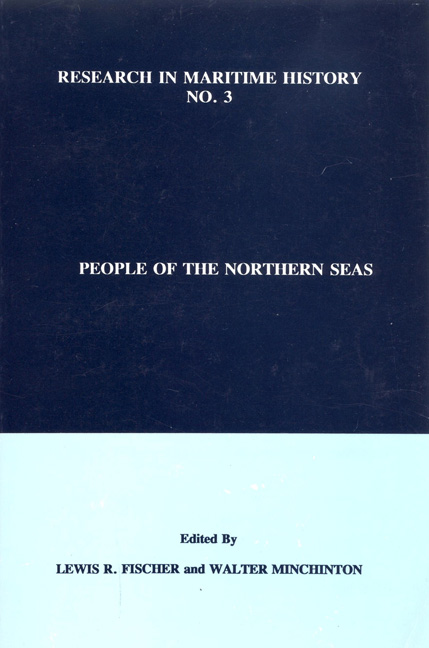Book contents
- Frontmatter
- Contents
- About the Editors
- Contributors
- General Introduction
- “Une Petite Republique” in Southwestern Newfoundland: The Limits of Imperial Authority in a Remote Maritime Environment”
- “Changes in Aleut Communities Following Russian Contact”
- “Five Years Before the Mast: Observations on the Conditions of Maritime Labour in Finland and Elsewhere”
- “Expressions of Longing, Sources of Anxiety? The Significance of Contacts with Home for Finnish Sailors in London and Hull in the Late Nineteenth Century”
- “Death of a Merchant”
- “St. Petersburg's Bills of Exchange in the Russian Economy of the Eighteenth Century”
- “Shipowners and Iron Sailing Ships: The First Twenty Years, 1838-1857”
- “The Growth of Norwegian Shipbroking: The Practices of Fearnley and Eger as a Case Study, 1869-1914”
- “Captain John Deane: Mercenary, Diplomat and Spy”
- “Her Majesty's Coastguard”
- “Coastal Life, ‘Nordic Culture’ and Nation State: Reflections on the Formation of the Nation State and Maritime History”
“Changes in Aleut Communities Following Russian Contact”
- Frontmatter
- Contents
- About the Editors
- Contributors
- General Introduction
- “Une Petite Republique” in Southwestern Newfoundland: The Limits of Imperial Authority in a Remote Maritime Environment”
- “Changes in Aleut Communities Following Russian Contact”
- “Five Years Before the Mast: Observations on the Conditions of Maritime Labour in Finland and Elsewhere”
- “Expressions of Longing, Sources of Anxiety? The Significance of Contacts with Home for Finnish Sailors in London and Hull in the Late Nineteenth Century”
- “Death of a Merchant”
- “St. Petersburg's Bills of Exchange in the Russian Economy of the Eighteenth Century”
- “Shipowners and Iron Sailing Ships: The First Twenty Years, 1838-1857”
- “The Growth of Norwegian Shipbroking: The Practices of Fearnley and Eger as a Case Study, 1869-1914”
- “Captain John Deane: Mercenary, Diplomat and Spy”
- “Her Majesty's Coastguard”
- “Coastal Life, ‘Nordic Culture’ and Nation State: Reflections on the Formation of the Nation State and Maritime History”
Summary
The year 1991 marked the two hundred fiftieth anniversary of the Russian discovery of the northwestern coast of North America by members of the Second Kamchatka Expedition. That discovery resulted in contact between the Russians and the inhabitants of the islands of the Aleutian archipelago. As in so many of the other early interactions between Europeans and indigenous groups, in the wake of Russian contact the Aleut population declined drastically and irreversible changes in indigenous patterns occurred. In spite of this, not all the consequences of contact with the Russians proved negative.
Many historians and anthropologists have painted a fairly simple picture of the Russian-Aleut relationship in which the latter were overwhelmed by the far greater strength of the former. This explanation, however, does not incorporate all relevant data and generalizes too broadly. Instead, neither Russian strengths nor Aleut weaknesses were as great as the traditional accounts suggest. For example, no Russian furhunting crew had more than sixty members, and they were customarily divided into three work groups. Twenty men, even with firearms, were not a particularly difficult challenge for the Aleuts. Moreover, the Aleuts had a tremendous advantage in that they knew the territory far better than the Russians. In short, many explanations of the Russian-Aleut relationship ignore several important elements which demonstrate that it was complex and far from static. This paper attempts to identify some of those operative factors and to suggest how they alter the more familiar accounts of the relationship between Russians and Aleuts.
One of the most important tasks of the Second Kamchatka Expedition, headed by Captain Vitus Bering and Alexei Chirikov, his second-in-command, was to determine conclusively whether the Asian land mass was connected to the Bolshoi Zemlia (“Great Land”) to the east. One of the two vessels that sailed in search of this information was commanded by Bering, the other by Chirikov. After the two became separated, Chirikov went on to make the first sighting of the northwestern North American coast and then returned to Russia.
Bering was less fortunate. He and his crew were shipwrecked near the island that now bears his name and forced to winter there. Although Bering and some of his men died before spring, the survivors were able to rebuild their vessel and sail back to Russia.
- Type
- Chapter
- Information
- People of the Northern Seas , pp. 35 - 46Publisher: Liverpool University PressPrint publication year: 1992



